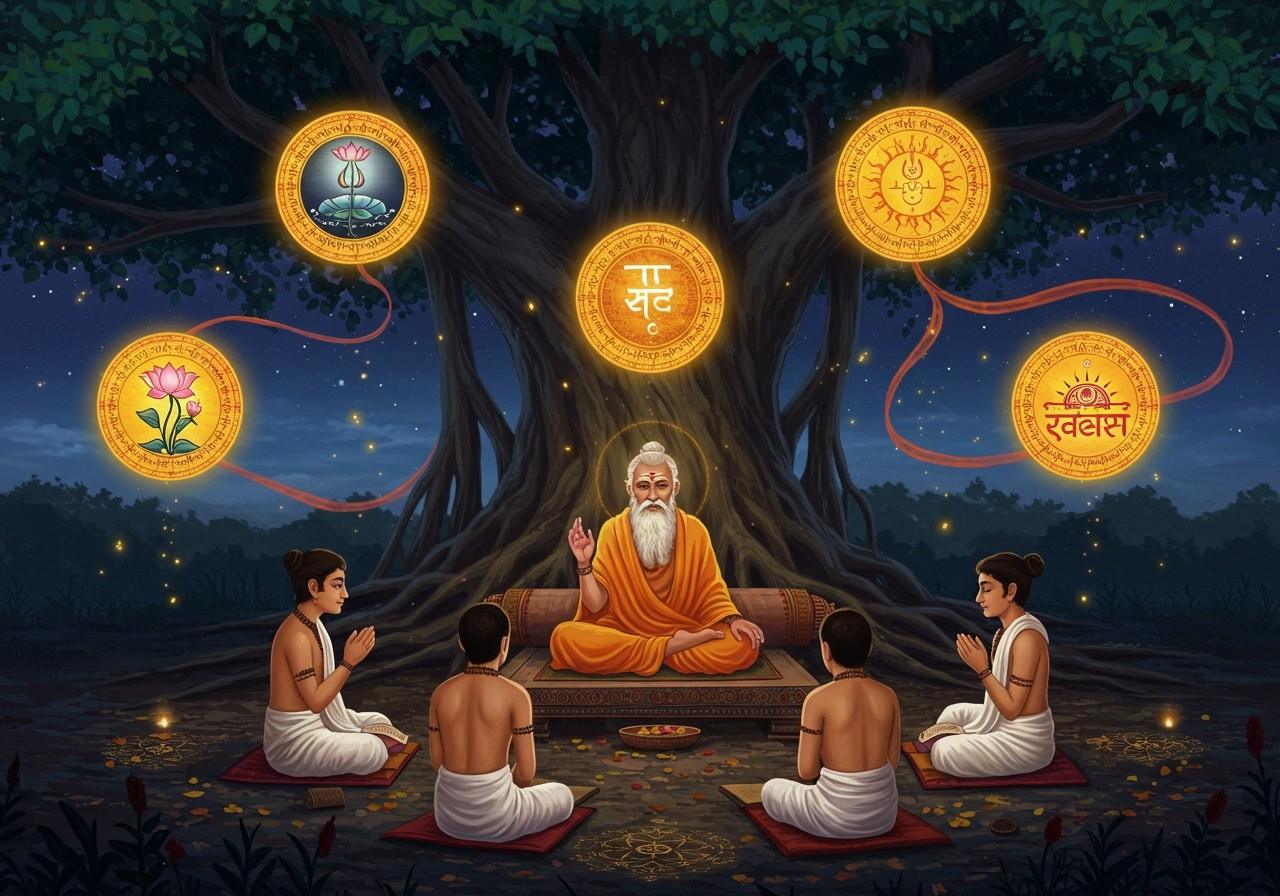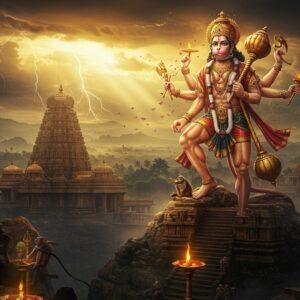
The Upanishads are ancient Hindu philosophical texts written in late Vedic Sanskrit, forming the foundation of Vedanta philosophy. As part of the Vedas, the oldest Hindu scriptures, they delve into profound spiritual and philosophical concepts like Samsara (the cycle of birth and death), Karma (the law of cause and effect), Dharma (righteous conduct), and Moksha (liberation). These texts primarily focus on meditation, philosophy, consciousness, and ontological knowledge, offering profound insights into the nature of reality, the self, and the universe. This guide explores the different types of Upanishads, their significance, and the Muktika canon of 108 Upanishads.
What are the Upanishads?
The term “Upanishad” literally means “sitting down near” which implies receiving wisdom from a teacher. They are the concluding parts of the Vedas, offering a philosophical and spiritual interpretation of the Vedic hymns and rituals. These texts emphasize meditation, morality, and metaphysical knowledge, significantly influencing later Hindu philosophy and religious practices. They offer profound wisdom and guidance for those seeking spiritual understanding and liberation.
Classifications of Upanishads
The Upanishads are categorized in various ways, offering a rich tapestry of spiritual and philosophical thought:
- Major Upanishads: These are the most prominent and widely studied Upanishads, including the Brihadaranyaka, Chandogya, Kena, Taittiriya, Aitareya, Kaushitaki, Isa, Katha, Mundaka, Mandukya, Prasna, and Svetasvatara Upanishads. They provide a comprehensive overview of core Upanishadic teachings.
- Mukhya Upanishads (Primary Upanishads): This category often overlaps with the major Upanishads, representing the most important and influential texts. They are considered foundational for understanding Vedanta philosophy.
- Khila Upanishads (Secondary Upanishads): These are lesser-known texts that are not always included in the traditional canon of 108 Upanishads. They explore specific deities, practices, or philosophical viewpoints.
- Categorization by Veda: Traditionally, 108 authoritative Upanishads are recognized and categorized under different Vedas: Rig Veda (10), Samaveda (16), Shukla Yajurveda (19), Krishna Yajurveda (32), and Atharvaveda (31). This classification reflects the association of each Upanishad with a particular Vedic school.
- Categorization by Deity: Upanishads can also be classified based on the deity they emphasize:
- Shakta Upanishads: These Upanishads focus on the goddess Shakti, the divine feminine energy. They explore the power and various forms of the goddess.
- Shaiva Upanishads: These Upanishads center on Lord Shiva, exploring his role as the destroyer, transformer, and source of wisdom.
- Vaishnava Upanishads: Dedicated to Lord Vishnu, these texts delve into his various incarnations, his role as the preserver, and the path of devotion (bhakti).
The Muktika Canon of 108 Upanishads
The Muktika canon, traditionally attributed to Rama’s instruction to Hanuman, lists 108 Upanishads. This collection encompasses a wide range of texts, including philosophical treatises, hymns, and ritual instructions. It represents a comprehensive compilation of Upanishadic literature. For a deeper dive into the Ramayana and Hanuman Chalisa, explore our resources: Ramcharitmanas: A Deep Dive into Devotion and Epic Narrative and Hanuman Chalisa: Meaning, Benefits, and Recitation.
Categories within the Muktika Canon
The Muktika canon further categorizes the 108 Upanishads into four groups:
- First Ten Upanishads: These are generally considered the most important and are often the same as the major Upanishads. They form the core of Upanishadic study.
- Samanya (General): These Upanishads address general philosophical and spiritual principles applicable to all seekers.
- Sannyasa (Renunciation): These Upanishads offer guidance for those who choose the path of renunciation, focusing on detachment and spiritual liberation.
- Yoga: These Upanishads explore the principles and practices of Yoga, emphasizing meditation, self-discipline, and union with the divine.
Reading the Upanishads
Embarking on the study of the Upanishads can be a transformative journey. Here are some recommendations:
- Start with the Major Upanishads: Begin with texts like the Isha, Kena, Katha, or Mundaka Upanishad to establish a strong foundation in core concepts. These offer a clear and concise introduction to Upanishadic thought. Poojn.in offers a variety of resources to support your study, including commentaries and translations.
- Utilize Commentaries: Explore commentaries by renowned scholars like Adi Shankaracharya to gain deeper insights into the complex philosophical ideas presented in the Upanishads. Commentaries can clarify interpretations and provide valuable context.
- Choose Clear Translations: Select translations that resonate with you and offer clear explanations, ensuring accessibility and understanding. Poojn.in provides a curated selection of translations to aid your study.
- Practice Meditative Reading and Reflection: Approach the Upanishads with a contemplative mindset, allowing time for reflection and integration of the teachings. Consider incorporating meditation practices to enhance your understanding.
Cultural and Ritual Significance
The Upanishads are deeply intertwined with Hindu culture and rituals:
- Recitation during Ceremonies: Mantras and passages from the Upanishads are often recited during Hindu ceremonies and rituals, adding a spiritual dimension to these practices. Poojn.in offers a wide selection of ritual items to enhance your ceremonies.
- Shaping Ethical and Moral Values: The ethical and moral principles enshrined in the Upanishads influence individual conduct and social values within Hindu society, promoting dharma and righteous living. For deeper exploration into Hindu scriptures and rituals, visit Hindu Scriptures: A Detailed Exploration and Hindu Rituals: A Guide to Coping with Grief and Loss.
- Influence on Contemporary Spiritual Practices: The Upanishads continue to inspire and inform contemporary spiritual practices, including yoga, meditation, and self-inquiry, offering timeless wisdom for modern seekers. Explore our collection of asanas, meditation cushions, and other spiritual tools at Poojn.in.
Conclusion
Understanding the Upanishads involves appreciating their profound wisdom and influence on Hindu traditions and rituals. These texts offer invaluable insights into meditation, morality, and the nature of existence. Whether you are a beginner or a seasoned scholar, exploring the Upanishads can be a deeply enriching experience, guiding you on your spiritual journey. For those interested in exploring the connection between Yoga and Ayurveda, visit Yoga & Ayurveda: A Holistic Wellbeing Approach. For those interested in mantra chanting, visit Mantra Chanting: Sound, Vibration, & Healing Power.


